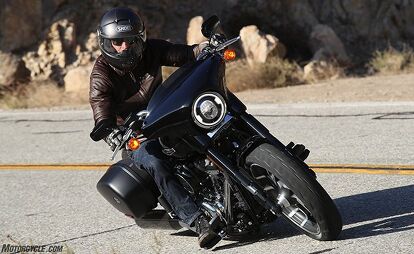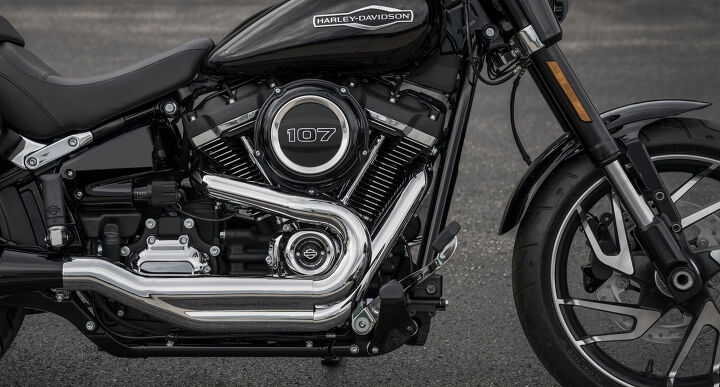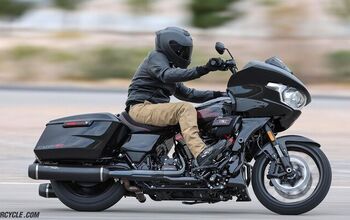2018 Harley-Davidson Sport Glide First Ride Review
Harley tweaks its new Softail platform with a sport-touring angle
The recent launching of a completely new Softail platform was somewhat overshadowed by the attendant axing of Harley’s Dyna platform. But after sampling this newest Softail, the Sport Glide, I’d like to add my voice to the chorus of motojournalists who have been effusive in their praise for the comprehensive engineering that has resulted in the best-performing Softails in H-D’s long history. The Sport Glide, the ninth new Softail, might be the best of the bunch.
2018 Harley-Davidson Sport Glide
| Engine | 18.5/20 |
| Suspension/Handling | 13.0/15 |
| Transmission/Clutch | 7.0/10 |
| Brakes | 7.0/10 |
| Instruments/Controls | 3.75/5 |
| Ergonomics/Comfort | 8.0/10 |
| Appearance/Quality | 9.0/10 |
| Desirability | 9.0/10 |
| Value | 7.5/10 |
| Overall Score | 82.75/100 |
Harley-Davidson Introduces All-New Softail Line For 2018
“The Softail program gave us the opportunity to reach into new classes,” explained Paul James, H-D’s Manger of Product Portfolio, at the Sport Glide’s riding introduction this week. James, an erstwhile roadracer, says this new Glide hearkens back to the FXRT Sport Glide from the 1980s and the FXDXT T-Sport from 2001. Since then, Harley has also sold bikes similar in concept, like the Dyna Convertible and Switchback.
But all those previous baggers can’t hold a candle to the performance, sleekness and refinement of this new FLSB Sport Glide, with significantly greater chassis rigidity and the new Milwaukee-Eight 107-cubic-inch motor delivering impeccable throttle response and a generous improvement in power production.
The timing of our ride coincided with the bike’s announcement at EICMA this week. The European audience is an important one for Harley, as it expects the Sport Glide might be the MoCo’s best-selling bike in that market. About 40% of Harley’s current sales are in the global market, and it’s aiming to increase that share to 50% in the coming years.
Fun Fact: Although there are but 25 H-D dealers in India, Harley owns the #1 spot in that nation’s 600cc-plus category. Harley operates CKD (Complete Knock Down) factories in India and Brazil to sidestep onerous import duties in those countries.
There are two key elements to the Sport Glide’s concept: First is the addition of modest wind protection from a shrunken version of Harley’s signature batwing fairing; additionally is the inclusion of stowage space via saddlebags, an important consideration for European riders who desire greater functionality from their motorcycles. A stripped-down appearance is available by both elements being quickly detachable without tools.
“The Sport Glide offers the thrilling dynamic capability of the new Softail platform with features that make it suited for both commuting and light touring,” explained Dave Latz, senior product planning manager at Harley-Davidson, in a media release.
To test the concept, Harley invited a quartet of journalists to ride the Sport Glide on the roads north of L.A. It would be my first experience with a new Softail, and I came away thinking the Sport Glide might be my favorite Harley of them all.
First things first: style. After all, it’s not only MO editors who believe that style is a primary selling point for motorcycles, and that’s especially true for Harleys. Paul James says many of H-D’s customers choose a bike based on the way it looks rather than the dynamic promises intended in their designs. “They view their choices through the lens of style,” James relates.
The Sport Glide visually distinguishes itself by its mini batwing windscreen, which mimics a Street Glide’s iconic fairing but on a much smaller scale: “The Big Twin equivalent of a training bra,” observed Senior Editor John Burns, who will be thrilled to know that cruise control is standard equipment on the SG. Below the screen is Harley’s Daymaker LED headlight framed by a distinctive ring of LEDs. Rear lighting is provided by a clean LED combo that incorporates the brake light into the rear turnsignals.
Other than the fuel tank, fenders and windscreen (available in black, silver or cherry), most of the rest of the Glide Lite is finished in black, with subtle highlights of chrome or polished metal accents on the engine, exhaust system, and new “Mantis” aluminum wheels specific to the Sport Glide. It’s an attractive motorbike, with its only styling flaw to be found with my eyes being the big gap between the front tire and its steel fender.
There’s not many surprises when throwing a leg over the SG, as it retains most of the elements of other Softails, including tank-top instrumentation that features an analog speedo, gear-position indicator, fuel level and a miles-to-empty tripmeter. It also has a numerical tach, but it’s nearly impossible to read while riding. In a nod to modernity, a USB charging port below the frame’s steering neck is provided to power electronic devices.
The ergos are cruiser-rangy with a slight sport set, with a 26.5-inch seat height working with modestly forward-set footpegs (no floorboards) that are a reasonable stretch. Some readers have opined they’d prefer mid-mount pegs, but that would fold legs uncomfortably with the bike’s squat seat height. The Sport Glide features a narrower (0.75 inch) primary case cover on the right side that allows legs a straighter shot at the ground and is likely to be fitted to some future Softail models. I appreciated the handlebar position, which puts a rider in a slight forward lean rather than a vertical posture that sends bump impacts through spinal columns.
The diminutive windscreen is barely visible from the cockpit, and it looks so good that we wonder if many riders will bother taking advantage of its detachable feature. Touring riders in colder climates might think it worthy to invest in the 5.5-inch windshield from H-D accessory catalog ($159.95), which is 4 inches taller than the stock lip.
The bags are also quickly detachable, but their capacities combine for just 1.9 gallons (7.2 liters) of space. H-D notes they can hold a half-helmet, a laptop and a rainsuit, so they’re designed more for commuting storage than for cross-country travel. An expandable bag setup would be appreciated by those who like to cover longer distances. For additional load capacity, Harley sells a luggage rack and a Tour-Pack mounting rack. A sissy-bar backrest is also available, which I’d recommend if you plan on carrying passengers, as the stock pillion pad has a an uneasy downward slope and a disappointingly low coefficient of traction.
A proximity sensor in the key fob enables convenient keyless ignition, and firing up the blacked-out 107 Milwaukee-Eight reveals a traditional Harley 45-degree V-Twin exhaust note. The 1746cc air/oil-cooled motor is bolted into the chassis without rubber mounts, so it is a stressed member of the frame, which Harley says is 65% more rigid than previous Softails and a massive 90% stiffer than the previous rubber-mount Dyna platform. Dual counterbalancers quell objectionable vibration while retaining an ever-present mechanical presence felt by a rider.
Peak torque arrives at just 2750 rpm, providing plenty of oomph to propel the SG down the road with ease. Harley claims 108 lb-ft of torque when rated at its crankshaft, and it performs so well that wishing for an upgrade to Harley’s 114-cube motor might be a fool’s errand for many. The 107 is a seriously good motor, with flawless throttle response and a strong and even pull through its rev range that provides solid thrust whenever it’s needed. The shift action from its six-speed tranny is more deliberate than slick, but gears are swapped reliably when not rushed.
Riders are adequately sheltered from engine heat, partly due to the oil cooling around the hottest areas of the cylinder heads, says Harley, with heat being shed by the bike’s oil cooler. At a standstill, a rider’s left calf will feel heat emanating from the clutch area.
A braided steel line provides a firm feel from a 4-piston caliper clamping on a 300mm rotor. A few of you have commented that a light-duty sport-tourer like the Sport Glide should be equipped with a dual-disc front brake setup, but Paul James notes that “A double-disc setup doesn’t really improve braking power, it just reduces lever effort.” Indeed, a strong squeeze on the comfortably doglegged brake lever can easily induce howling from the front tire before the standard ABS fully kicks in, and I had no indication of fade even when railing hard down Glendora Mountain Road. A generously sized 292mm rotor and 2-piston caliper slows the rear wheel, combining for a brake setup I’d describe as perfectly adequate for the vast majority of riders.
Harleys aren’t known for exemplary suspension performance, but the company has taken steps forward with the Showa components on the Softail platform. The Sport Glide uses a 43mm inverted cartridge fork fitted with tri-rate springs to support its 5.1 inches of travel. It’s non-adjustable because, professes Harley, research says most riders with adjustable suspensions neglect to hone in on a setup that best suits their weight or riding style and never bother to adjust them, potentially giving a worse setup than a simple non-adjustable suspension. FWIW, the cartridge fork in the Sport Glide (and Fat Bob) is higher-tech design than the dual-bending-valve fork of the other Softails.
What is adjustable is the underseat shock’s preload, handily able to be set via a hand-tunable hydraulic adjuster. For my 150-pound weight, James advised preload to be set at position 2 of 5, and it proved to provide admirable compliance within the rear wheel’s 3.4 inches of travel.
I was pleased with the SG’s overall handling. Although it’s no lightweight (supposedly 698 pounds “in running order”), the new Softail chassis gives the bike a solid structure that feels much more composed than previous Harley Big Twins. A 30.0-degree rake and 150mm of trail results in steering characteristics that aren’t quick, but a deliberate shove on the bars delivers immediate responses without the flex associated with previous chassis.
Cornering clearance, always a bugaboo with cruisers, is decent if not bounteous, allowing a fairly rapid pace while devouring curvy mountain roads. Watching a pack of Harleys banking over in twisty corners made me think of a big airplane like a B-17 doing aerobatics, rewarding deliberate but smooth arcs. It can keep up a surprisingly swift pace on a canyon road, delivering more fun in corners than I had expected.
Harley’s Fat Bob has 2-degree sharper rake angle (28 degrees) and dual-disc brakes, as well as a longer shock (which can be fitted to a Sport Glide) that increases cornering clearance. Perhaps a hybrid Fat Glide might one day be in the cards.
Other details? Mirrors are located inconspicuously but are nicely useful for checking your six, and self-cancelling turnsignals mean you never look like a forgetful octogenarian. A two-piece clutch cable enables easy accessorizing, such as fitting a taller handlebar. The seamless 5-gallon fuel tank should enable more than 200 miles between fills. Like all Harleys, the Sport Glide has a two-year unlimited-mileage warranty.
Conclusion
The Sport Glide turns out to be perhaps the most appealing bike in Harley’s lineup, at least for my tastes. It builds on the estimable refinement of the new Softail platform and boasts added versatility from its onboard storage, modest wind protection, cruise control, and the convertible nature from its detachable touring elements. Add in faultless power from the 107-inch motor, secure handling and attractive styling, and the Sport Glide will doubtlessly appeal to a new slice of the market which desires a Harley that is usable for more than just looking nice down at the Burger Barn.
2018 Harley-Davidson Sport Glide
+ Highs
- Dashing good looks
- Added versatility
- Good bones (motor and chassis)
– Sighs
- Bags smaller than they appear
- Brakes merely adequate
- Poor passenger accommodations
2018 Harley-Davidson Sport Glide Specifications | |
|---|---|
| MSRP | Vivid Black: $18,599 Twisted Cherry: $18,999 Silver Fortune: $18,999 |
| Engine Type | Milwaukee-Eight 107 Engine |
| Displacement | 107 cu. in. (1,746 cc) |
| Bore | 3.937 in. (100 mm) |
| Stroke | 4.375 in. (111 mm) |
| Torque | 108 lb-ft (claimed) |
| Transmission | 6-Speed, Cruise Drive |
| Frame | Mild steel, tubular frame; rectangular section backbone; stamped, cast, and forged junctions; MIG welded; aluminum forged fender supports |
| Swingarm | Mild steel, tubular sections, stamped x-member, forged axle junctions; MIG welded; removable belt spacer |
| Front Suspension | Single cartridge 43mm inverted forks with aluminum fork triple clamps; triple rate spring, 5.1 in. travel |
| Rear Suspension | Hidden, free piston, coil-over monoshock; 43mm stroke; toolless hydraulic pre-load adjustment, 3.4 in. travel |
| Front Brakes | 4-piston fixed caliper, 300mm rotor |
| Rear Brakes | 2-piston floating caliper, 292 mm rotor |
| ABS | Standard |
| Wheels | Black, machine highlighted, Mantis cast aluminum |
| Tires Front | 130/70B18 63H BW |
| Tires Rear | 180/70B16 77H BW |
| Length | 91.7 in. (2,329 mm) |
| Seat Height | 26.5 in. (673 mm) |
| Fuel Capacity | 5 gal. |
| Dry weight | 670 lb. (claimed) |
More by Kevin Duke









































































































Comments
Join the conversation
https://uploads.disquscdn.c...
my "OLD" 2000 Pro-Street-Bagger
without bags: https://www.hotbikeweb.com/...
What I want from Harley-Davidson - and I am a big fan of Harley-Davidson - is a Standard based upon the Touring Platform, like a Road King, only without the bags, highway lights, bulbous headlamp or electronic gimmickry, and with a flat, two man seat, wide handlebars and a 2-into-1 exhaust. A Street King. Harley Heaven.